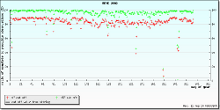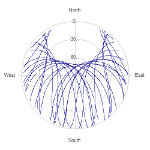
CHARLESTON
Station summarySCCC
| IGS-type acronym : | SCCC |
| Latitude : | 32.78300000 |
| Longitude : | -79.93300000 |
| Installed date : | 2004-10-13 |
| Decommissioned date : | 2014-09-02 |
| Country : | U.S.A. |
| City: | CHARLESTON |
| Station status : | Decommissioned (white and red cross) |
| Distance to Tide Gauge (m) : | 913 |
| Domes Nr.: | 49406M001 |
| Station operator: | Unknown |
| IGS-like station form : |
GPS position times seriesSCCC
Position
(Reference epoch: )
(Reference epoch: )
Offsets (mm)
| M | Material change or malfunction |
| E | Earthquake |
| RF | Reference Frame change |
| U | Unknown |
| NA | Not available |
| Position discontinuity | |
| Velocity discontinuity |
Data available at SONELSCCC
Quality plots on RINEX filesSCCC
 |
 |

Plots generated using software developed with the EPN team at ROB |
| Observations & tracking performance | Satellite tracking |
 (this operation may take 20 to 45s)
(this operation may take 20 to 45s)
The satellite tracking graph has been calculated for all stations for the first day of each month. If you wish to have a graph for another date, choose the 'Calculate a specific date' option.
Comparison with satellite altimetry data
- Link to Sea Level Differences (Satellite altimetry minus tide gauge data).
Co-located instrumentsSCCC
- GPS : Charleston 1 (CHA1)
- GPS : Charleston (SCHA)
- Tide gauge : CHARLESTON (SCHTG)
- GPS : FORT JOHNSON (SCFJ)



 Ezer, 2013. Sea level rise, spatially uneven and temporally unsteady: Why the U.S. East Coast, the global tide gauge record, and the global altimeter data show different trends. Geophysical Research Letters.
Ezer, 2013. Sea level rise, spatially uneven and temporally unsteady: Why the U.S. East Coast, the global tide gauge record, and the global altimeter data show different trends. Geophysical Research Letters.












